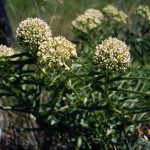Antelopehorn Milkweed, Antelope-Horn
Asclepias asperula
Asclepiadaceae
Description
Antelopehorn Milkweed grows to about 8 inches or 20 cm tall. It consists of several unbranched stems growing out of a stout base forming a mound that reaches just under a meter wide. Keel-shaped, simple, alternate leaves with prominent main veins are narrow (< 3 cm), lance-shaped, and up to 8 inches or 20 cm long. They are narrowly acuminate at the apex. Ricky Linex in Range Plants of North Central Texas describes the flower head as “an umbrella shape resembling half a popcorn ball with numerous corollas showing five purplish petals surrounded by cream and pale green colors.” Flowering can occur from March to November. The fruit is a wrinkled pod containing silk-tufted seeds.Habitat
Most abundant in western Texas, this plant has also been recorded in the northern, central, and east central regions of the state. It survives in many soil types and prefers full sunlight. It reaches north into Nebraska and west into southern Utah and southeastern California. It often abounds in open pastures, along arroyos, draws, bar ditches, trails, and roadsides.Toxic Agent
The toxic agents involved are cardiac glycosides. Antelopehorn Milkweed poisons all livestock, especially sheep. A toxic dose is generally considered to be 1.2 percent of the animal's body weight in green plant material.Signs of Livestock Ingestion
Signs of poisoning produced by most species of Asclepias differ only in degree. They include: First, profound depression, weakness, and staggering; Collapse, followed by frequent, intermittent muscular tremors; Labored respiration, elevated temperature, and pupil dilation; Death after a comatose period of variable duration. Signs appear within a few hours of ingestion of a toxic dose, and death follows within a few days in most fatal cases.Management Strategies
Animals dislike the taste of milkweeds and seldom graze them unless they are hungry and confined to milkweed-infested areas. Most losses are caused by overgrazing and drought. The plant is most toxic before it matures, somewhat less as it dries. Antelopehorn Milkweed retains enough toxicity to be dangerous in hay. Although most animals die if they reach the convulsive stage of milkweed poisoning, some recover. Move them to shade, keep them quiet, and give them plenty of food and water. No medicinal treatment is specified, but sedatives, laxatives, and intravenous fluids may help.Images
Plant Characteristics
Flower Color: Green, Yellow
Seed Type: Bean/Pod
Duration: Perennial
Stem Texture: Hairless/Smooth
Growth Habit: Forbs/Broadleaf
Leaf Shape
 : Simple with Pinnate or Parallel Venation
: Simple with Pinnate or Parallel Venation
Season: Warm
Distribution
 : 02 - Gulf Prairies and Marshes, 03 - Post Oak Savannah, 04 - Blackland Prairies, 05 - Cross Timbers and Prairies, 06 - South Texas Plains, 07 - Edwards Plateau, 08 - Rolling Plains, 09 - High Plains, 10 - Trans-Pecos
: 02 - Gulf Prairies and Marshes, 03 - Post Oak Savannah, 04 - Blackland Prairies, 05 - Cross Timbers and Prairies, 06 - South Texas Plains, 07 - Edwards Plateau, 08 - Rolling Plains, 09 - High Plains, 10 - Trans-Pecos
Distributions
Distribution refers to the ecological region in Texas that a plant has been found. You can also view a clickable map.
Book: Toxic Plants of Texas (B-6105)
Collection: Toxics, Wild Flowers
Livestock Affected: Cattle, Goats, Horses, Sheep
Livestock Signs: Colic, Depression/ Weakness, Diarrhea, Incoordination, Irregular Breathing, Seizures, Trembling





